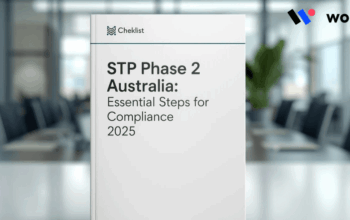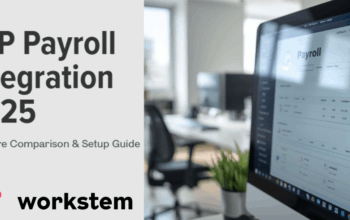Table of content
- Common STP Compliance Failures & The ATO Penalty Structure
- ATO Audit Triggers & Red Flag Indicators
- Prevention Strategies: Automated vs. Manual Approaches
- Case Study: How Workstem Automation Prevented $15k in ATO Penalties
- How Workstem Helps Manage STP Obligations?
- FAQs About the Single Touch Payroll (STP)
Single Touch Payroll (STP) is more than a reporting duty; it’s a key compliance pillar for the ATO. With the system now well-established, the ATO’s focus has shifted from education to enforcement. For Australian businesses, understanding STP penalties and the triggers of an ATO STP audit is critical for 2025.
This guide will walk you through the common compliance failures, how the ATO identifies issues, and why STP compliance automation with a platform like Workstem is your most powerful defence against financial penalties.
Common STP Compliance Failures & The ATO Penalty Structure
The ATO can issue penalties for failures to report correctly or on time. The most common mistakes include:
- Late Reporting: Submitting your STP report after the deadline (usually the day you pay your employees). Fines can be applied per 28-day period you are late.
- Incorrect Data: Submitting data with errors, such as wrong Tax File Numbers (TFNs), inaccurate gross pay amounts, or misclassified employment types. This can lead to incorrect tax and super records for employees.
- Missing Employees: Failing to include all eligible employees in a pay event submission.
- Finalisation Failures: Not finalising your employees’ information at the end of the financial year by the due date (14 July).
The ATO’s penalty system is based on a points system, with fines escalating based on the size of your business and the severity and frequency of the infringement. For small businesses, penalties can start at over $200 per failure.
ATO Audit Triggers & Red Flag Indicators
The ATO uses sophisticated data-matching technology to review STP submissions. You don’t want to raise a red flag. Key audit triggers include:
- Data Inconsistencies: Significant variances between the amounts you report in STP and your Business Activity Statements (BAS) or Super Guarantee (SG) contributions.
- Unusual Patterns: Reporting for an inconsistent number of employees each period, or reporting zero wages for employees who previously had regular income.
- TFN Discrepancies: A high number of submitted TFNs that don’t match ATO records.
- Consistent Late Filing: A history of missing the reporting deadline is a clear sign of compliance issues.
- Employee Complaints: If the ATO receives complaints from employees about incorrect payslips or superannuation, it will likely cross-reference this with your STP data.
Prevention Strategies: Automated vs. Manual Approaches
The fundamental choice for businesses is between manual data handling and automated software solutions. The risk profile of each is vastly different.
The Manual Approach (High Risk):
Relying on spreadsheets and manual data entry into the ATO’s portal is fraught with risk. It requires perfect human execution every single pay cycle. A single typo in a TFN, a miscalculation of overtime, or simply forgetting to press “submit” can trigger compliance action.
The Automated Approach (Low Risk):
Using an ATO-approved STP software like Workstem embeds compliance into your payroll process. Here’s why 73% of STP errors are preventable with automation:
- Eliminates Late Reporting: Submission happens automatically upon finalising pay runs.
- Reduces Data Entry Errors: Employee data is stored securely and applied consistently.
- Validates Information: Systems can run checks on TFNs and pay calculations before submission.
- Ensures Finalisation: Automated reminders and workflows ensure you meet the end-of-year deadline.
Automation transforms STP from a stressful, manual compliance task into a seamless, background process that protects your business.
Case Study: How Workstem Automation Prevented $15k in ATO Penalties
The Business: A multi-location restaurant chain with over 80 employees, including full-time, part-time, and casual staff under the Hospitality Award.
The Problem: The business was using a basic accounting software for payroll and manually submitting STP reports. Due to complex award interpretation involving evening, weekend, and public holiday penalties, their manual calculations were frequently incorrect. This led to inconsistent STP data and underpayment issues, putting them at high risk of ATO audit and Fair Work penalties. Their finance team estimated potential fines could exceed $15,000.
The Workstem Solution: The business implemented Workstem’s all-in-one payroll and HR platform. Key features that mitigated their risk:
- Built-in Award Interpretation: Workstem automatically applied the correct penalty rates and allowances based on clock-in/out times, eliminating calculation errors.
- Seamless STP Automation: Every pay run was calculated accurately and submitted to the ATO directly from the platform with one click, ensuring timeliness and data consistency.
- Centralised Employee Records: A single source of truth for all employee details ensured no one was missed and all information was current.
The Outcome: The restaurant chain has now completed 12 months of flawless STP reporting. Their payroll data is consistent with their BAS and super obligations. They have eliminated the risk of late fees and calculation-error penalties, effectively saving themselves from over $15,000 in potential ATO fines and protecting their brand reputation from underpayment scandals.
How Workstem Helps Manage STP Obligations?
Ensure your business remains compliant effortlessly. Let Workstem’s automated payroll and integrated STP Phase 2 reporting handle the complexity for you. Explore Workstem’s STP Solution today and ensure peace of mind with every pay run.
Simplify award interpretation and payroll processing with Workstem, the all-in-one workforce management & payroll software designed for every industry. Workstem is an ATO-approved STP Phase 2 solution that simplifies compliance by automating the entire process:
- Built-in Validation: Workstem’s software is designed with the correct STP Phase 2 fields and categories, guiding you to enter data correctly and reducing errors.
- Seamless Integration: As an all-in-one platform, Workstem integrates time & attendance, payroll, and STP reporting. This eliminates manual data entry between systems, ensuring the data you report is accurate and consistent.
- Easy Submissions: Reporting is done with a single click at the end of each pay run, with immediate confirmation from the ATO.
- Simplified Finalisation: The year-end finalisation process is streamlined and can be completed in minutes.
Choose from our Standard or Advanced plan to suit your business needs, and stay Fair Work compliant with confidence.
FAQs About the Single Touch Payroll (STP)
Q1: What is Single Touch Payroll (STP) in simple terms?
A: Single Touch Payroll (STP) is a mandatory Australian government initiative that requires businesses to report their employees’ payroll information—such as salaries, wages, pay-as-you-go (PAYG) withholding, and superannuation—to the Australian Taxation Office (ATO) directly from their payroll software each time they run payroll. It’s “single touch” because the reporting happens with a single action at the same time as you pay your staff.
Q2: Who needs to report through STP?
A: Essentially, all Australian employers must report through STP. If you have even one employee, you are generally required to use STP.
Q3: What is the difference between STP Phase 1 and STP Phase 2?
A: STP Phase 2 expands the reporting requirements introduced in Phase 1. The key difference is the level of detail provided to the ATO.
- STP Phase 1 reported total amounts for key figures like gross earnings and tax withheld.
- STP Phase 2 requires a detailed, disaggregated breakdown of an employee’s income (e.g., separating salary, overtime, allowances, and leave payments).
Q4: What are my ongoing STP reporting obligations?
A: Your main ongoing obligations are:
- Report Each Pay Event: Submit the required data to the ATO on or before every pay day.
- Year-End Finalisation: Finalise your data by 14 July each year. This declares the information for the financial year is complete and correct. This replaces the need to provide payment summaries to your employees.
- Keep Records Accurate: Ensure employee details in your payroll software are always up-to-date (e.g., tax declarations, super fund choice).
Q5: I missed the STP Phase 2 migration deadline. What should I do?
A: You should take action immediately:
- Contact your software provider to start the transition process.
- Lodge a voluntary disclosure with the ATO to explain the delay. The ATO generally looks favorably upon businesses that come forward voluntarily and may provide you with a compliance plan or extra time to transition.
- Ensure you are using an ATO-approved STP Phase 2 solution, like Workstem, to become compliant.
Q6: How does STP help with my employees’ Superannuation?
A: While STP itself does not pay your super, it reports the liability for superannuation to the ATO each payday. This allows the ATO to better monitor and ensure that employers are meeting their super guarantee obligations on time. You still need to pay your super contributions to your employees’ funds by the quarterly due dates.
Q7: Does STP change when I have to pay my tax and super?
A: No. STP is a reporting system, not a payment system. The due dates for paying the PAYG withholding tax you report to the ATO and your super guarantee contributions to funds remain unchanged.
Q8: What happens if I make a mistake in my STP report?
A: Mistakes can be fixed. If you discover an error in a past submission, you can make a STP amendment through your payroll software. You simply correct the information in your system and submit a revised update to the ATO. It’s important to correct errors as soon as you find
Q9: Where can I find official information from the ATO?
A9: The best source of truth is always the official ATO website. You can find comprehensive guides, news, and resources on their Single Touch Payroll for employers page.
Book a free demo with our payroll experts and experience how Workstem can streamline your payroll and workforce operations.
Read More:
STP Phase 2 Australia: Post-Migration Compliance Guide & Requirements
Single Touch Payroll 2025: Everything Australian Employers Need to Know
Guide to Single Touch Payroll for Closely Held Payees








